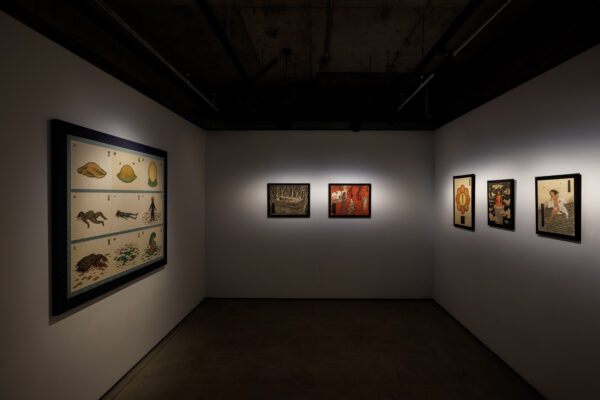틀의 변용
2024. 5. 9 - 6. 15 | [VISIT] ocimuseum
이영욱
OCI미술관(관장 이지현)은 신진작가 지원 프로그램 2024 OCI YOUNG CREATIVES의 선정 작가인 이영욱의 개인전 《틀의 변용》을 5월 9일부터 6월 15일까지 OCI미술관 2층에서 선보인다.
이영욱은 ‘반복’이라는 형식의 변용을 통해 익숙함과 생경함이 공존하는 제3의 형태를 창조한다. 실재하는 형상들이 해체되고, 뒤틀리며 불러일으키는 기이한 감각을 통해 인간의 문명 내 고착된 선입견에서 벗어난 낯선 세계를 제시한다.

관찰자를 바라보는 이들은 자신들의 숙명을 이해하고자 했다_불안으로 비틀어진 돌출된 시선과 이미지_acrylic on linen_193.3×260.6㎝_2024
물감을 분사하는 방식인 에어브러시를 사용하여 사실적인 묘사로 구체적인 형상들을 재현한다. 신체의 물리적 거리에 따라 다양한 표현이 가능하고, 섬세하고 매끄러운 표현으로 디지털 이미지와 유사한 분위기를 자아낸다. 또한, 이미지 자체를 강조하기 위해 작가의 제스처를 숨기는 장치로 작용한다.

무리에서 벗어나는 이는 배척당할 이유가 충분하다_불안함으로 비틀어진 돌출된 시선과 이미지_1_acrylic on linen_193.3×260.6㎝_2024
캔버스 표면에 안착한 형상들은 기존의 형태를 강조하는 동시에 은폐하면서 돌연변이 혹은 괴물의 모습으로 재생성된다. 층층이 중첩된 잔상은 마치 흔들리듯 부유하는 대상에 대한 불안함과 공허함을 암시한다.

20개의 손_acrylic on linen_193.3×130.3㎝_2024
연속되는 프레임 속에 갇혀 꿈틀거리더니, 이내 유동적인 형태로 되살아 난다. 작가의 손을 거쳐 조작된 일련의 덩어리들은 경직된 형식의 틀에서 벗어나 공간을 누비며 화면을 가득 채운다. 이렇게 탄생한 이미지는 유기적인 표현을 향한 끊임없는 실험과 탐구의 결과물이다.

목줄 없이 산책하는 개(1인칭 작가 시점에서 바라본 대상)_자코모 발라의 작품을 통해 연구한 반복_acrylic on linen_193.3×130.3㎝_2024
이번 전시에서는 1호 사이즈의 소품부터 600호 사이즈의 대작을 포함한 20여 점의 평면 회화 작업과 조각, 설치 작업들을 선보인다. 평면과 입체의 관계를 탐구하는 작가로서 이전에는 다양한 실험을 통해 매체의 확장에 초점을 두고 접근하는 방식을 중점적으로 보았다면, 이번 전시에서는 ‘반복’적인 이미지를 구축하고, 전달하는 과정을 회화적으로 풀어내는데 초점을 맞춰 접근해보고자 한다.
OCI미술관
서울특별시 종로구 우정국로 45-14
02-734-0440
[VISIT] ocimuseum
- Dates
- 2024. 5. 9 - 6. 15











